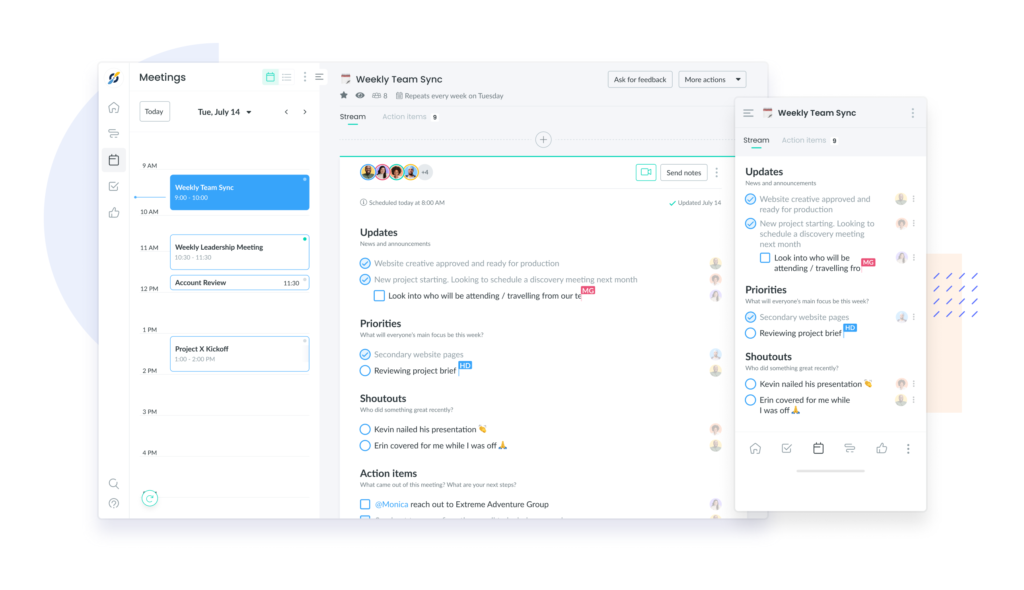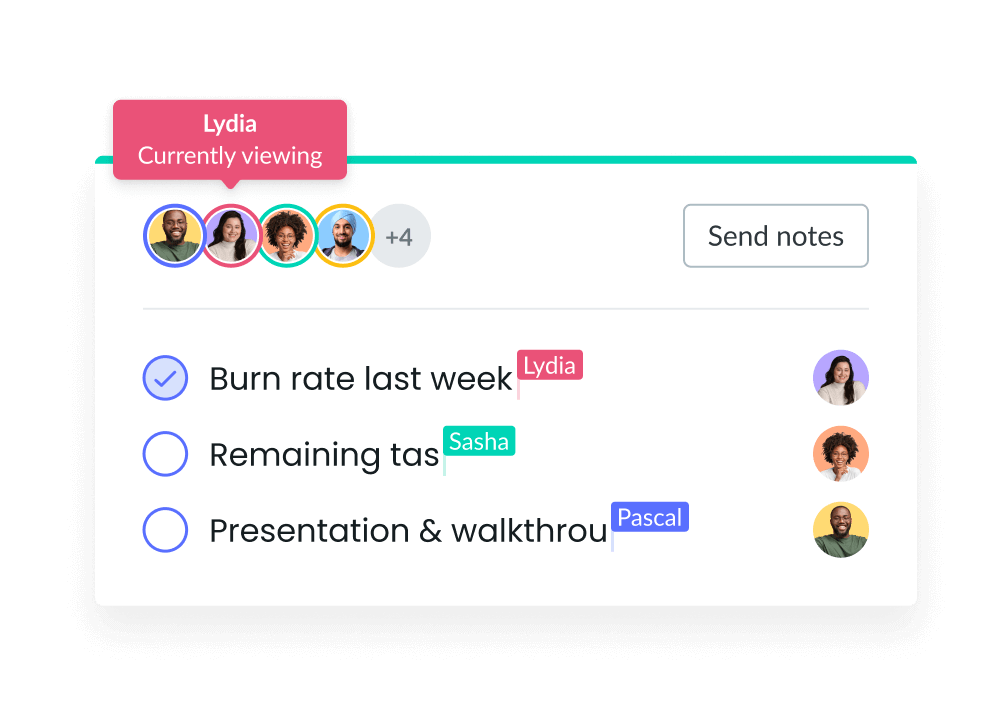Synchronous vs. Asynchronous Communication: A Guide For Managers
7 Frequently asked questions and best practices to get the best of synchronous and asynchronous communication.
One of the biggest challenges in managing a remote team is figuring out the most effective way to communicate with each person (without interrupting their workflow). Should you message them, schedule a call, or send an email instead?… Knowing the difference between synchronous and asynchronous communication will help you improve your team’s productivity and collaboration.
Synchronous communicates in the moment, where asynchronous communicates over a period of time. Some organizations prefer one over the other, although successful companies choose a blended approach to get the best of both worlds.
If you’re wondering when to choose synchronous vs. asynchronous communication, you came to the right spot. Here are 7 frequently asked questions we’ll cover in this post:
- What is synchronous communication?
- What is asynchronous communication?
- The main difference between synchronous and asynchronous communication
- Pros and cons of synchronous communication
- Pros and cons of asynchronous communication
- Best practices for synchronous communication
- Best practices for asynchronous communication
1 What is synchronous communication?
Synchronous communication happens in real time, where at least two individuals are exchanging information, at the same time with each other. That’s not to say that you need to be communicating in person for this to be deemed synchronous communication. This type of communication can be virtual as well, either scheduled or a little more impromptu.
Examples of synchronous communication
- In-person meeting
- Phone call
- Video conference (i.e., via Zoom, WebEx, Slack, etc)
- Asking the teammate across your desk a quick question
- Coffee break conversations

2 What is asynchronous communication?
Asynchronous communication is communication that has a lag between when a message is sent and when the person receiving it interprets it. This type of communication isn’t generally conducted in person, nor is it planned for or scheduled.
Examples of asynchronous communication
- Letters or direct mail
- Project management tools
- Text messaging
- Direct messaging
- Video recordings (i.e., via Loom, Vidyard, CloudApp, Drift Video, etc)
- Asynchronous meetings
- Notes and action items in a Shared stream
3 The main difference between synchronous and asynchronous communication
There are a few differences between synchronous and asynchronous communication. The main difference is that synchronous communications happen in the moment, meaning that it’s faster and more dynamic. This means that it’s also good for participation and active discussions with smaller groups.
Conversely, asynchronous communication happens over a period of time, so there’s no need to schedule anything! You can go at your own pace, without as many disruptions.
Asynchronous communication is better for working with different time zones as it creates a permanent record of ideas, decisions, and discussions.
Basically, synchronous communications happen in real-time, where asynchronous communications happen over a period of time. Each communication style is used for exchanging information in situations that are best suited for one or the other, respectively.
4 Pros and cons of synchronous communication
There are pros and cons as well as a time and place to engage in synchronous communication. Let’s check out some of the positive attributes and some of the disadvantages of synchronous communication.
Benefits of synchronous communication:
- In-depth interactions: Synchronous communications administer the opportunity for more in-depth interactions. Think about meetings where you can use live discussions to brainstorm or solve problems, something that wouldn’t be possible in an asynchronous environment. You can even record discussions or team meetings and share them with your team later if they were unable to attend.
- Real-time resolutions: A recent article by Arc highlights another advantage of synchronous communications:
“Real-time online communication enables [employees] to address different issues on the spot. You don’t have to wait to get the most pressing problems fixed. Production can keep moving forward, because you don’t need to wait for someone else’s response.”
Using this real-time online communication is going to save your team time waiting for a response and therefore your productivity won’t be delayed waiting for a team member to get back to you.

Pro tip
Meetings are a great example of synchronous communication. By using a meeting agenda tool like Fellow, you can ensure that all your meetings have a clear purpose, detailed agenda, and assigned action items.

Disadvantages of synchronous communication:
Where there are some great attributes of synchronous communications, of course there are a few unfavourable characteristics that could present challenges to you and your team.
- Disrupts focus: Even though most people find it a lot easier to talk in real-time, it can really disturb an individual’s focus. If you’re in the middle of working on something, with a pressing deadline, you’re probably not going to give 100% of your attention to the person standing at your desk or pinging you via Slack. You might even look for the quickest solution available so that you can get back to your work. The quality of this conversation is then greatly diminished.
- Tough on time zones: In the article mentioned above, Arc communicates a further disadvantage of synchronous communication:
“…since these conversations occur in real-time, time zone differences profoundly impact the quality of synchronous communication. While a call’s time may be optimum for some, for others it may be well into the night. This disrupts work-life balance and contributes to employee burnout.”
If you manage a remote team and have members of your team sitting in different time zones, chatting in real-time can be challenging and even frustrating for that person who has to take a call at 9:00 PM on a Friday. Imagine if these late calls become recurring… That employee may begin to feel agitated.
5 Pros and cons of asynchronous communication
Just like synchronous communication, asynchronous communication also has some pros and cons. Let’s check them out:
Benefits of asynchronous communication:
- Enable flexibility: One key advantage of asynchronous communication is that it enables flexibility because there’s less pressure to answer immediately. When there isn’t this huge pressure on team members to respond as quickly as possible, they can focus on the quality of their response and give the message their full attention when it suits them best. Less pressure and stress means happier and more engaged employees.
- Time-zone friendly: One of the most noteworthy advantages of asynchronous communication is that you don’t have to consider time zones and coordinating meeting times. This idea is reinforced by Darren Murph, Head of Remote at Gitlab:
“As a remote team, you can’t be sure that anyone is available or online at any given time,” says Darren Murph. “We try to reduce the reliance on synchronicity to get work done. And that means we have to document things as we go so that other people around the company will have access to the most up to date information.“
Pro Tip
Instead of scheduling a specific time for your daily standup meeting, ask your teammates to add talking points and action items to the Fellow note asynchronously. This is a great way to know what each person is working on, without taking too much time or interrupting their workflow.

Disadvantages of asynchronous communication:
- Lacks sense of immediacy: Unfortunately, asynchronous communications can lack the sense of immediacy that managers are looking for. Because the interaction isn’t in real-time, actions can’t be made immediately and require some time. Asynchronous communication can’t be an actual conversation because there’s quite a delay or lag between when the message is sent and when it is processed by the recipient. This less immediate interaction can leave you hanging and uses your valuable time.
- Disconnect in communication: With asynchronous communications, you need to be extremely clear and detailed with your message because the conversation isn’t happening in real-time and is much slower in nature. This idea is highlighted by Mary Cullen, president and founder of Instructional Solutions:
“Asynchronous communication requires patience and planning. These qualities are generally virtuous but have practical limitations,” says Cullen. “Asynchronous communication cannot handle urgent situations. If a client requires an immediate reply, synchronous communication is required externally and internally. There are times when urgent or sensitive matters require synchronous communication, and it’s important to be able to recognize and respond accordingly.”
6 Best practices for synchronous communication
Identify the right instances to use synchronous communication
It’s the right time to engage in synchronous communication if you need an immediate response, if it’s going to be a short, less complex discussion, and if you have a clear objective in mind for this conversation.
Ask for instant feedback
Instant feedback can be asking if right now is a good time to talk, to ask if your co-worker or counterpart thinks the matter is urgent, or if they’re the right person to be chatting to.
Focus on a personal connection
The way in which we communicate is really important. Think about going into these discussions openly, politely and respectfully to build stronger relationships with your team members.
Plan even when it’s impromptu
Even if you’re just stopping at your co-workers’ desk for an opinion on something, think about the urgency of this discussion and what you’d like out of it. It’s important to respect other peoples’ time and to consider that they likely have other projects with tight deadlines that they’re working on.
Similarly, if you’re scheduling a meeting to discuss something with your team, make sure you design a meeting agenda in advance.

7 Best practices for asynchronous communication
Identify the right instances to use asynchronous communication
It’s the right time to engage in asynchronous communication if you don’t need an answer urgently, you need to chat with someone in a different time zone (who isn’t working the same hours as you), or if you want to communicate a message to a group of people who can’t all get together at the same time.
Be clear and detailed
Because of the lag time associated with this type of communication, you need to be extremely transparent with the information that you’re sharing and to keep as organized as possible.
Use the right tools
Make sure you’re using the right tools that your teammates are going to be the most receptive to. We recommend checking out the following asynchronous communication tools:
- Slack
- Microsoft Teams
- Project Management tools such as Basecamp and Asana
- Video recording tools such as Loom, CloudApp, and Vidyard
- Google Drive
- Voice recordings
- Fellow (asynchronous meeting agendas)
Conclusion
Managing a remote team can be challenging, especially when it comes to choosing the most effective way to communicate with your group. Failing to find the appropriate means to communicate with team members often results in confusion, misalignment and underperformance.
In order to manage your team successfully, it’s important to understand when to use synchronous communications and when to use asynchronous communications.
Refer back to this guide whenever you need a reminder of what these styles of communication bring to the table and best practices to communicate effectively with your team members!











